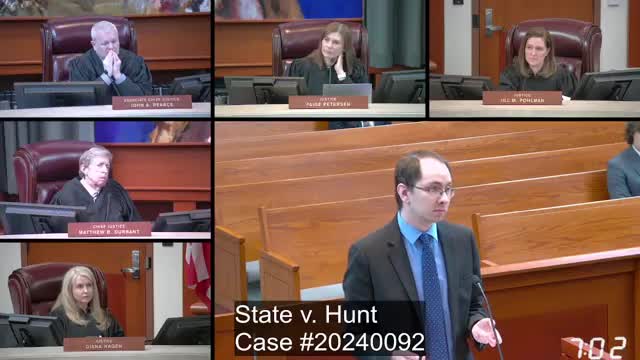Defense attorney argues self-defense lacks support in defendant's shooting case
May 07, 2025 | Utah Supreme Court, Utah Judicial Branch, Utah
This article was created by AI summarizing key points discussed. AI makes mistakes, so for full details and context, please refer to the video of the full meeting. Please report any errors so we can fix them. Report an error »

In a recent session of the Utah Supreme Court, the case of State v. Hunt #20240092 was the focal point of intense legal scrutiny, particularly surrounding the issues of self-defense and the admissibility of evidence. The discussions highlighted the complexities of determining reasonable use of force in violent encounters, as well as the implications of jury instructions on the outcome of such cases.
Central to the arguments was the defense's claim of self-defense, which was challenged by the prosecution's assertion that the defendant, Hunt, was the aggressor in the incident. Testimonies from multiple witnesses contradicted Hunt's account, depicting him as having threatened and physically assaulted the victim before using lethal force. The prosecution argued that the absence of corroborating evidence for Hunt's claims—specifically, the alleged presence of a weapon—significantly undermined his defense. The court deliberated on whether a jury could reasonably conclude that Hunt acted in self-defense, given the overwhelming evidence against his narrative.
A key point of contention was whether the jury could be misled by the instructions provided, particularly if they believed Hunt's testimony but still found that his perception of danger was unreasonable. The court concluded that even if the jury accepted parts of Hunt's account, they could still evaluate the reasonableness of his actions based on the evidence presented. This underscores the critical role that jury instructions play in shaping the jury's understanding of self-defense laws.
Additionally, the admissibility of a 911 call recording was debated, with concerns raised about its potential to evoke strong emotional responses from jurors. The defense argued that the recording could unfairly prejudice the jury against Hunt, while the prosecution maintained that it was relevant to establishing the timeline of events and the credibility of witnesses. The court acknowledged the emotional weight of such evidence but ultimately deemed it necessary for a comprehensive understanding of the case.
As the court navigated these complex legal issues, the discussions illuminated the broader implications for self-defense cases in Utah. The outcome of this case could set important precedents regarding the interpretation of self-defense laws and the standards for evidence admissibility in future trials. The court's decision is anticipated to have significant ramifications for both defendants and victims in similar circumstances, highlighting the delicate balance between legal rights and public safety.
Central to the arguments was the defense's claim of self-defense, which was challenged by the prosecution's assertion that the defendant, Hunt, was the aggressor in the incident. Testimonies from multiple witnesses contradicted Hunt's account, depicting him as having threatened and physically assaulted the victim before using lethal force. The prosecution argued that the absence of corroborating evidence for Hunt's claims—specifically, the alleged presence of a weapon—significantly undermined his defense. The court deliberated on whether a jury could reasonably conclude that Hunt acted in self-defense, given the overwhelming evidence against his narrative.
A key point of contention was whether the jury could be misled by the instructions provided, particularly if they believed Hunt's testimony but still found that his perception of danger was unreasonable. The court concluded that even if the jury accepted parts of Hunt's account, they could still evaluate the reasonableness of his actions based on the evidence presented. This underscores the critical role that jury instructions play in shaping the jury's understanding of self-defense laws.
Additionally, the admissibility of a 911 call recording was debated, with concerns raised about its potential to evoke strong emotional responses from jurors. The defense argued that the recording could unfairly prejudice the jury against Hunt, while the prosecution maintained that it was relevant to establishing the timeline of events and the credibility of witnesses. The court acknowledged the emotional weight of such evidence but ultimately deemed it necessary for a comprehensive understanding of the case.
As the court navigated these complex legal issues, the discussions illuminated the broader implications for self-defense cases in Utah. The outcome of this case could set important precedents regarding the interpretation of self-defense laws and the standards for evidence admissibility in future trials. The court's decision is anticipated to have significant ramifications for both defendants and victims in similar circumstances, highlighting the delicate balance between legal rights and public safety.
View full meeting
This article is based on a recent meeting—watch the full video and explore the complete transcript for deeper insights into the discussion.
View full meeting

